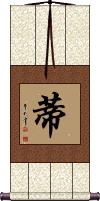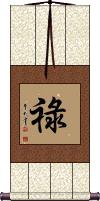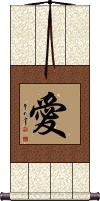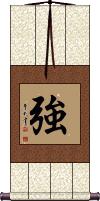Many custom options...
And formats...

Tee in Chinese / Japanese...
Buy a Tee calligraphy wall scroll here!
Personalize your custom “Tee” project by clicking the button next to your favorite “Tee” title below...
Triple Truth of Japanese Buddhism
人間性を再生するのは寛容な心親切な言葉奉仕と思いやりの精神 is known as the Triple Truth of Buddhism in Japanese.
The Buddha ordered that all should know this triple truth...
A generous heart, kind speech, and a life of service and compassion are the things that renew humanity.
That is the English translation most commonly used for this Japanese Buddhist phrase. You might have seen this on a coffee cup or tee shirt.
Note: Because this selection contains some special Japanese Hiragana characters, it should be written by a Japanese calligrapher.
Prosperity
(also means salary)
祿 is occasionally used in China to mean prosperity or good fortune.
祿 once meant the “official's salary” in old feudal China and Korea (obviously, the officials lived well, so you can imagine how this was associated with the idea of being prosperous).
祿 is only used in Korean historical documents for “salary.” In old Japanese, this means fief, allowance, stipend, reward, pension, grant, and sometimes happiness depending on context. It's very obscure in modern Japanese.
We have other entries that are better suited for a prosperity wall scroll. This entry just addresses “the coffee cup issue” where this character has been used on coffee cups and tee-shirts. However, without context, the meaning is ambiguous to some.
Love
愛 universally means love in Chinese, Japanese Kanji, old Korean Hanja, and old Vietnamese.
愛 is one of the most recognized Asian symbols in the West and is often seen on tee shirts, coffee mugs, tattoos, and more.
愛 can also be defined as affection, to be fond of, to like, or to be keen on. It often refers to romantic love, and is found in phrases like, “I love you.” But in Chinese, one can say, “I love that movie” using this character as well.
This can also be a pet name or part of a pet name in the way we say “dear” or “honey” in English.
This can be a girl’s name “Ai” in both Chinese and Japanese.
More about this character:
This may be hard to imagine as a westerner but the strokes at the top of this love character symbolize family & marriage.
![]() The symbol in the middle is a little easier to identify. It is the character for "heart" (it can also mean "mind" or "soul"). I guess you can say that no matter if you are from the East or the West, you must put your heart into your love.
The symbol in the middle is a little easier to identify. It is the character for "heart" (it can also mean "mind" or "soul"). I guess you can say that no matter if you are from the East or the West, you must put your heart into your love.
![]() The strokes at the bottom create a modified character that means "friend" or "friendship."
The strokes at the bottom create a modified character that means "friend" or "friendship."
I suppose you could say that the full meaning of this love character is to love your family, spouse, and friends with all of your heart, since all three elements exist in this character.
See Also: I Love You | Caring | Benevolence | Friendliness | Double Happiness Happy Marriage Wall Scroll
Strong / Powerful / Force
強 is a character that means strong, strength, force, powerful, better, stubborn, and stiff (yes, all of this in one character).
This “strong” has less to do with physical strength and more to do with having a winning attitude, or just having the ability to win at something.
Note that most of the time, this character is pronounced “qiang” but when used with the meaning of stubborn, unyielding, or stiff, it is pronounced “jiang” in Chinese.
Also, sometimes “qiang” is used in modern Chinese to describe people that do crazy things (For example: Bicycling from Beijing to Tibet alone). I sometimes can be found outside my Beijing apartment wearing nothing but shorts and a tee-shirt while eating ice cream during a snow storm, just to hear my neighbors call me “qiang.” Maybe they mean “strong” but perhaps they are using the new meaning of “crazy strong.”
強 can also be a Chinese surname that romanizes as Jiang in the mainland or Chiang if from Taiwan.
強 is a valid Korean Hanja character with the same meaning but is mostly used in compound Korean words.
強 is used in Japanese (though normally in compound words). In Japanese, it has the same meaning but in some contexts can mean “a little more than...” or “a little over [some amount].” Most Japanese would read this as tough, strength, stiff, hard, inflexible, obstinate, or stubborn.
The variant 彊 is sometimes seen in older literature.
This in-stock artwork might be what you are looking for, and ships right away...
These search terms might be related to Tee:
Forgiveness (From the Top Down)
Highest Quality / Top Notch
Top Quality / First Class
Not the results for Tee that you were looking for?
Below are some entries from our dictionary that may match your Tee search...
| Characters If shown, 2nd row is Simp. Chinese |
Pronunciation Romanization |
Simple Dictionary Definition |
ティー see styles |
dii / di ディー |
More info & calligraphy: Tee |
定英 see styles |
teiei / tee ていえい |
(given name) Teiei |
手江 see styles |
tee てえ |
(surname) Tee |
球座 see styles |
qiú zuò qiu2 zuo4 ch`iu tso chiu tso |
tee (golf) |
發球 发球 see styles |
fā qiú fa1 qiu2 fa ch`iu fa chiu |
(tennis etc) to serve; (golf) to tee off |
開桿 开杆 see styles |
kāi gǎn kai1 gan3 k`ai kan kai kan |
to tee off (golf); to break (snooker) |
開球 开球 see styles |
kāi qiú kai1 qiu2 k`ai ch`iu kai chiu |
open ball (math.); to start a ball game; to kick off (soccer); to tee off (golf) |
Variations: |
tii / ti ティー |
(1) T; t; (2) (See トン) ton; tonne; (3) (See ターミナル) (airport) terminal; (4) (abbreviation) (colloquialism) (See Tシャツ,白ティー) T-shirt; tee; (5) (abbreviation) (See タテ目) long grain (paper); (prefix) (6) (See 大正) nth year in the Taishō era (1912.7.30-1926.12.25) |
いひひ see styles |
ihihi いひひ |
(interjection) hee-hee; tee-hee |
えへへ see styles |
ehehe えへへ |
(interjection) (onomatopoeic or mimetic word) heh heh heh; tee-hee; giggle |
チーズ see styles |
chiizu / chizu チーズ |
(1) {food} cheese; (2) tee (piping); T-joint; (interjection) (3) (usu. as はい、チーズ) cheese (said when taking a photograph) |
Tシャツ see styles |
tiishatsu / tishatsu ティーシャツ |
T-shirt; tee shirt |
ティーオフ see styles |
tiiofu / tiofu ティーオフ |
tee off |
ティー・オフ see styles |
tii ofu / ti ofu ティー・オフ |
tee off |
ティーアップ see styles |
tiiapu / tiapu ティーアップ |
(noun/participle) tee-up; teeing (golf) |
Variations: |
ihihi; ihihi いひひ; イヒヒ |
(interjection) (onomatopoeic or mimetic word) hee-hee; tee-hee |
Variations: |
ufufu; ufufu うふふ; ウフフ |
(interjection) (feminine speech) (onomatopoeic or mimetic word) tee-hee |
ティー・アップ see styles |
tii apu / ti apu ティー・アップ |
(noun/participle) tee-up; teeing (golf) |
ティーショット see styles |
tiishotto / tishotto ティーショット |
tee shot (golf) |
ティグラウンド see styles |
tiguraundo ティグラウンド |
tee (golf) (wasei: tee ground); teeing ground |
Variations: |
ufun; ufuun / ufun; ufun うふん; うふーん |
(interjection) (1) (feminine speech) (onomatopoeic or mimetic word) tee-hee; (interjection) (2) (feminine speech) (onomatopoeic or mimetic word) mmh (moan); aah |
ティ・グラウンド see styles |
ti guraundo ティ・グラウンド |
tee (golf) (wasei: tee ground); teeing ground |
ティー・ショット see styles |
tii shotto / ti shotto ティー・ショット |
tee shot (golf) |
ティーグラウンド see styles |
tiiguraundo / tiguraundo ティーグラウンド |
tee (golf) (wasei: tee ground); teeing ground |
ティー・グラウンド see styles |
tii guraundo / ti guraundo ティー・グラウンド |
tee (golf) (wasei: tee ground); teeing ground |
ティーバッティング see styles |
tiibattingu / tibattingu ティーバッティング |
tee batting |
ティー・バッティング see styles |
tii battingu / ti battingu ティー・バッティング |
tee batting |
Variations: |
tii(p); ti(p) / ti(p); ti(p) ティー(P); ティ(P) |
(1) tea; (2) tee |
Variations: |
tiiofu; tii ofu / tiofu; ti ofu ティーオフ; ティー・オフ |
tee off |
Variations: |
tiishotto; tii shotto / tishotto; ti shotto ティーショット; ティー・ショット |
{golf} tee shot |
Click here for more Tee results from our dictionary
The following table may be helpful for those studying Chinese or Japanese...
| Title | Characters | Romaji (Romanized Japanese) | Various forms of Romanized Chinese | |
| Tee | 蒂 | dì / di4 / di | ti | |
| Tee | ティー | tii / ti | ||
| Triple Truth of Japanese Buddhism | 人間性を再生するのは寛容な心親切な言葉奉仕と思いやりの精神 | ningensei o saisei suruno wa kanyou na kokoro shinsetsu na kotoba houshi to omoi yari no seishin ningensei o saisei suruno wa kanyo na kokoro shinsetsu na kotoba hoshi to omoi yari no seishin | ||
| Prosperity | 祿 禄 | fuchi | lù / lu4 / lu | |
| Love | 愛 爱 | ai | ài / ai4 / ai | |
| Strong Powerful Force | 強 强 | kyou / kyo | qiáng / qiang2 / qiang | ch`iang / chiang |
| In some entries above you will see that characters have different versions above and below a line. In these cases, the characters above the line are Traditional Chinese, while the ones below are Simplified Chinese. | ||||
Successful Chinese Character and Japanese Kanji calligraphy searches within the last few hours...













